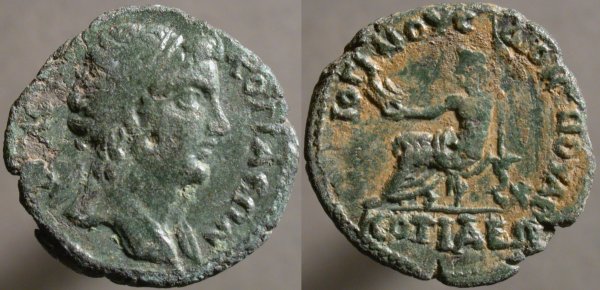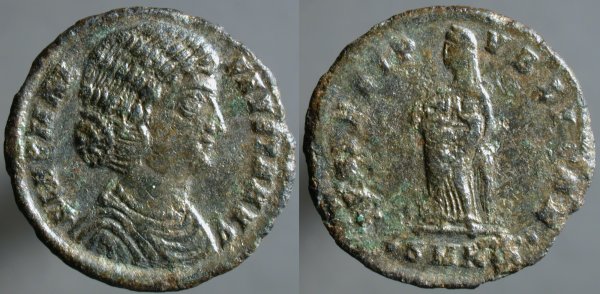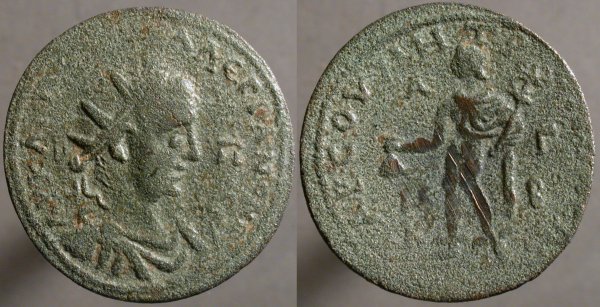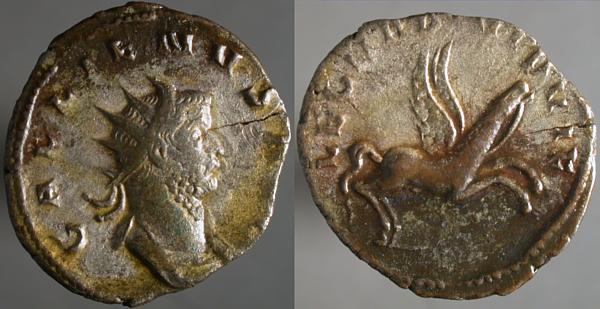Friday, May 12, 2006
Æ23, Cotiaeum in Phrygia, quasi-autonomous, SNG von Aulock 3776

ΔHMOC KOTIAEΩ_N, Diademed head of Demos right | [EΠI] ΔIOΓE_NOY ΔIONYCIOY APX, Zeus seated left. holding scepter with left hand, eagle perched on his right hand. KOTIAEΩ[N] in exergue.
I've previously posted coins, here and here, that, like this one, were issued "in the year of archon Diogenes Dionysus." He's not otherwise remembered to history, but as archon he'd have been a civic official, and have been responsible for seeing that there were adequate funds for taxes due to Rome and for any local games and observances.
Thursday, May 11, 2006
Æ sesterius, Valerian, Rome, Göbl 22i

IMP C P LIC VALERIANVS AVG, Laureate cuirassed bust right | FIDES MILITVM, Fides standing left, holding a standard to either side, S_C across fields.
I don't think anybody knows if the Romans cared at all if their coins were round, but sestertii of this era certainly show they tolerated rather square examples. From the details of the obverse legend, we know this coin was from Valerian's earliest issues at Rome. Rather than getting worse than this from here, sestertii would largely be discontinued early in the sole reign of Valerian's son, Gallienus.
Wednesday, May 10, 2006
Æ3, Fausta, Cyzicus, RIC 50

FLAV MAX FAVSTA AVG, Bare head with waved hair, mantled bust right | SPES REIPVBLICAE, Empress standing facing, head left, with a child in each arm. ·SMKΔ· in exergue.
Flavia Maxima Fausta was married to Constantine and may have arrranged for the execution of his oldest son, Crispus to better clear the way for her own sons Constantine II, Constantius II, and Constans.
Her own death quickly followed that of her stepson, rumored to have been at the urging of Constantine's mother Helena, then newly arrived in Rome from Bithynia to travel to Judea and search for Christian sites and artifacts.
Tuesday, May 09, 2006
Æ35, Tarsus in Cilicia, Valerian, SNG PFPS 1463

AV K Λ[... OVA]ΛEPIANON [...], Radiate draped cuirassed bust right, Π before and behind | TAPCOV MHTP[...], Hermes standing left holding purse in right hand and caduceus with left. A / [M / K] in left field, Γ / B in right field.
Frequently imperial coins featuring a diety will give as a clue, in the legend, why that god or goddess was chosen. Provincial coins rarely do. I know of no special connection between Hermes and Tarsus. Wikipedia, notes his role as
“the god of boundaries and of the travelers who cross them, of shepherds and cowherds, of orators, literature and poets, of athletics, of weights and measures and invention and commerce in general, of liars, and of the cunning of thieves”in addition to his role as messenger of the gods.
It's not clear if one of these chacteristics prompted his choice here as a suitable symbol for the city to use on their coin, the evidence of which has endured.
Monday, May 08, 2006
Billon antoninianus, Gallienus, Mediolanum, Göbl 990r

GALLIENVS AVG, Radiate cuirassed bust right, both ribbons behind | LEG II ADI VI P VI F, Pegasus springing right.
As with all the coins in the "legionary series", the reverse shows the name and badge of a legion loyal to Gallienus in wars against usurpers. The legion here is Legio II Adiutrix, raised by Vespasian in 70 CE.
With their visual connection to emblems carried by the legions, the legionary coins are favorites with both Gallienus specialists and more-general collectors alike.

